Yamba, New South Wales 作者: 来源: 发布时间:2021-06-04
I. Population and Area
Total Area: 16.9 km²
Population in 2016: 6,076
https://quickstats.censusdata.abs.gov.au/census_services/getproduct/census/2016/quickstat/SSC14458
II. Natural Geography
-Climate
Here are some average weather facts we collected from our historical climate data:
During the month of April, May, August, September and October you are most likely to experience good weather with pleasant average temperatures that fall between 20 degrees Celsius (68°F) and 25 degrees Celsius (77°F).
Most rainfall (rainy season) is seen in January, February, April and June.
The warmest month is January with an average maximum temperature of 28°C (82°F).
The coldest month is July with an average maximum temperature of 18°C (65°F).
April is the most wet month. This month should be avoided if you are not a big fan of rain.
September is the driest month.
https://weather-and-climate.com/average-monthly-Rainfall-Temperature-Sunshine,yamba-new-south-wales-au,Australia
-Geography
Yamba may not have the super luxurious beachfront apartments and boutiques of Noosa or the celebrity status of Byron Bay but there’s no doubt there’s a bit of a buzz happening around the seaside town of Yamba. Like most seaside towns on Australia’s east coast, this lovely coastal destination is rapidly changing from a surfing destination to a holiday destination and there’s a growing number of things to do in Yamba.
Although Yamba is on the north coast of New South Wales, it’s closer in weather, distance and beach culture to Brisbane than it is to Sydney. In some ways, Yamba feels like Noosa before the boom.
Surrounded by national park, the Clarence River and beautiful beaches, it’s easy to see why Yamba is becoming a go-to spot for a quintessential Aussie beach holiday.
A population of 7000 swells over Christmas and Easter when Yamba’s motels and caravan parks are packed with summer holidaymakers.
Also read this post for the best Australian landmarks to visit while travelling around the country.
Yamba is 670km from Sydney on the north coast of New South Wales and 300km from Brisbane.
The closest airports are Grafton, which is a regional airport that has flights from Sydney, and the Gold Coast airport is a 2.5-hour drive away.
Surfers started visiting Yamba in the 1960s and a National Surfing Reserve was established in Angourie in 2007.
https://travel2next.com/yamba/
-Transportation
Operating between Ballina Airport and the Yamba/ Maclean area in the beautiful Clarence Valley.
The Airport Shuttle operates between Yamba, Maclean and Ballina (Servicing Illuka and Woodburn)
Shuttle will operate on bookings only.
Home/Motel/Resort pick-up and drop-off available in Yamba
https://www.yambashuttle.com.au/
Getting Here
Angourie Resort is situated between the quaint township of Angourie and the coastal fishing village of Yamba. Located just 2.5 km from Yamba’s CBD and is set amongst 600 hectares of remnant littoral rainforest. Yamba is 3 hours (280 km’s) drive south of Brisbane and 7 hours (640 km’s) north of Sydney.
By Car – Driving North
On the Pacific Highway drive south from Brisbane approximately 280km. Take the Yamba exit off the Pacific Highway and head along the Clarence River to Yamba, approximately 14kms. There is only one road in & out of Yamba, so you should find it easy to navigate.
By Car – Driving South
On the Pacific Highway drive north from Sydney approximately 670km. Take the Yamba exit off the Pacific Highway and head along the Clarence River to Yamba, approximately 14kms.
By Bus
All major bus companies travel the Pacific Highway and have arrangements to stop either at Maclean CBD or on the Pacific Highway at the Ferry Park Tourist Complex on the outskirts of Maclean. Greyhound Australia travel to Yamba daily, visit https://www.greyhound.com.au/ for schedules.
By Minibus Transfer
Brisbane to Yamba Tours is a tour operator offering transfers and tours to Yamba from Brisbane via Gold Coast Airport in their ten-seater commuter bus. Offering four services a week in the southbound direction from Brisbane to Yamba via Gold Coast airport. To view their full schedule or to make a booking visit https://www.brisbanetoyambatours.com.au/
By Air
There are several regional airports with flights to a variety of destinations within a 75-minute drive of Yamba. Alternatively, there is an international airport at Coolangatta, which is only a 2-hour drive north of Yamba.
Clarence Valley Airport (Near Grafton)
Clarence Valley airport is approximately 1 hour drive (70km south west) from Yamba along the Pacific Highway. Regional Express (REX), provide daily services between Grafton and Sydney (via Taree). Thrifty, Hertz, Budget and Avis all offer car hire options at the airport.
Ballina Airport
Ballina airport is approximately 1 hour 20min drive (100kms north) from Yamba along the Pacific Highway. Jetstar and Virgin Blue, provide daily jet services between Ballina and Sydney. While Regional Express (REX), provides multiple daily flights between Ballina and Sydney. There are several transport options to get from the airport to Yamba including Ballina Transport, Yamba Taxi Service or car rental from Thrifty. All must be prearranged before landing.
Gold Coast Airport (Coolangatta)
Gold Coast Airport is approximately a 2-hour drive (190kms north) from Yamba along the Pacific Highway. All the major airlines fly into Coolangatta from a variety of destinations – Newcastle, Sydney, Canberra, Melbourne, Adelaide, Cairns, Townsville, Darwin, Auckland and Christchurch.
Coffs Harbour Airport
Coffs Harbour Airport is approximately a 1 hour 45min drive (140kms south) from Yamba, along the Pacific Highway. Airlines including Jetstar, Virgin Blue and Qantas fly into Coffs Harbour daily.
By Train
NSW Trainlink travel to Grafton daily and arrive at Grafton City Railway Station with connections to CountryLink buses that will deliver you to Yamba. Alternatively, arrangements can be made with the Clarence Valley Airport Shuttle Service from Grafton to Yamba.
https://angourieresort.com.au/getting-here/
III. Economy

https://quickstats.censusdata.abs.gov.au/census_services/getproduct/census/2016/quickstat/SSC14458
IV. Industrial Characteristics
With a little lighthouse, a big river, a marina, a fishing fleet, great beaches with Norfolk pines and some groovy restaurants and cafes, Yamba somehow combines just about everything people enjoy in coastal towns. To top it all off, the CSIRO and Stanford University described the area has have the ‘world’s best climate’, an enviable combination of sunny summers and mild winters which the locals love and visitors enjoy.
Fish are what Yamba is often about, starting with the fishing industry which goes back to the early days of settlement and still plays a major role in the town. The view of the fleet setting out down the river and across the bar at sunset is best enjoyed from Lighthouse hill, and at night the lights of the fleet can often be seen twinkling on the horizon. Amateur anglers also enjoy the range of opportunities Yamba offers, with rock, beach, estuary or deep sea fishing spots. Boats can be hired or chartered and houseboats and cruisers are another holiday possibility. Even just a ferry trip across the Clarence to Iluka is a great way of enjoying the water, sightseeing, and discovering new fishing spots. Seafood fanciers will also enjoy the oysters farmed in this prime setting.
With new housing, accommodation and retail developments making the most of this scenic spot, Yamba looks poised to move into a more sophisticated future, with tourism playing an important role alongside the traditional industries. An emphasis on good regional cuisine, particularly seafood, has seen several local restaurants develop regional followings.
https://www.visitnorthcoast.com.au/see-the-clarence/yamba/
Key Projects:
Yamba
About the Yamba Sewerage Project: Technical details
The Yamba Sewerage Strategy was developed by Clarence Valley Council in collaboration with the Yamba Water Recycling Management Committee (YWRMC) and NSW state government agencies.
High level treatment. The existing Yamba STP will be upgraded to optimise existing facilities and harness best practice technology. The capacity of the STP will be expanded to meet the demands of the estimated ultimate population growth (page 26 of Environmental Impact Statement) and peak holiday periods on the Yamba peninsular (17,200 EP). A higher standard of treatment will produce recycled water suitable for irrigation of public spaces and release into the natural environment. For the technically minded the upgrade includes two new secondary treatment tanks which use an “intermittent decant extended aeration” (IDEA) activated sludge process with diffused aeration and tertiary treatment of sand filtration using up-flow filters and UV disinfection, with chlorination of recycled water for reuse.
Collection & transport. The system of collection and transportation of sewage, known as ‘reticulation’, will be upgraded. Low-flow pressure sewer systems (which are currently used at Iluka, Lawrence and Oyster Channel) will be introduced into new development areas. Groundwater infiltration into the pipes will be minimised, reducing the volume of wastewater needing to be treated at the STP.
Maximum re-use. Highly treated recycled water will be used to irrigate sporting fields including the Yamba Golf Course and, in the future, Angourie Road Sports Complex, Yamba Public School, Yamba Oval and possibly the Yamba Bowling Club. Further opportunities will be pursued as they arise, with the goal of maximising use of recycled water in order to reduce irrigation costs for public open spaces and minimise the volume of recycled water released into the natural environment.
Ebb-tide release.During periods when all the recycled water cannot be re-used through irrigation, such as in wet weather, excess recycled water will be released into the middle of the Clarence River near its mouth, on an outgoing tide. This was the preferred option according to the Environmental Impact Statement (2005). For more technical details about ebb-tide release, refer to Council’s website.
Water efficiency. Maximising use of recycled water will mean that less of our valuable drinking water is used for purposes such as irrigation. Implementing other water-efficiency measures for our drinking water supply also means that less wastewater will be produced, treated and released.
This approved strategy was then developed into the Yamba Sewerage Augmentation Project. The Yamba project is the last stage of Council’s $160 million valley-wide sewerage upgrading project which has upgraded sewage treatment in Grafton and Maclean, and extended reticulated sewerage to Lawrence and Iluka.
Stages of the Yamba Sewerage Project have included:
Development of the Yamba Sewerage Strategy (adopted by Council, November 2003)
Project approval (Environmental Impact Statement approved, December 2005)
Detailed Concept Design (adopted by Council, July 2008)
Detailed Design of pipeline systems, Sewage Treatment Plant (STP), recycled water irrigation and ebb-tide release (completed early 2012)
Environmental approval of ebb-tide release (Review of Environmental Factors adopted by Council, September 2014)
Construction – upgrade of STP began in February 2014, and drilling for the ebb-tide release in July 2015.All major components of the Yamba Sewerage Project should be complete by February 2016, barring unforeseen weather or technical difficulties. For regular construction updates see Council’s website
Facts & Figures:
The overall Yamba Sewerage project budget is $43 million, and is being primarily funded by Council with some financial assistance from the NSW Government through its Country Towns Water Supply and Sewerage Scheme.Development and design of the project cost $3 million and construction has comprised two construction contracts – the STP upgrade awarded to Haslin Constructions ($21.1 million) and the reticulation and ebb-tide release construction awarded to Ledonne Contractors ($15 million).Construction project management and works insurance is costing $2.1 million.As with all construction projects it is likely that some contract variations will be required during the work and the budget for the construction contracts allows for 5% contingency for variations.
Key consultants/contractors engaged in the project include Sinclair Knight Merz (Environmental Impact Statement); John Wilson & Partners (Detailed Concept Design); WorleyParsons and NSW Water Research Laboratory (Detailed Design); GHD (Review of Environmental Factors); Haslin Constructions (upgrade of STP); and Ledonne Constructions (ebb-tide release and pipework).
https://www.clarence.nsw.gov.au/cp_themes/metro/page.asp?p=DOC-VSW-83-36-77
Yamba Sewage Treatment Plant
Project Background
Moddex were selected by Haslin Constructions to supply WHS compliant handrails with toeboards for stairs, elevated walkways and platforms for the Yamba Sewerage Treatment Plant. While the design brief nominated traditionally fabricated solutions, our proprietary Aluminium systems were ultimately selected for modular flexibility, no-weld assembly, advanced corrosion resistance and cost efficiencies.
Products/configurations used on project
Tuffrail TR20
Why was Moddex product selected?
The Yamba Sewerage Treatment Plant handles large flows of water, wastewater and chemical treatments. With corrosion resistance as a key driver for a quality, long-term solution, Moddex presented technical data on the composition of our AlyMag® range to demonstrate compliance with Australian Standard 1657 and corrosion resistance. Our no-weld construction methods made installation safer on-site streamlining the installation process, enhancing corrosion resistance and eliminating costly site shut-downs, firespotters or hot works permits.
Our systems were delivered off-the-shelf direct to site over three stages in line with the project’s construction phases. With installation required at elevated levels, a prefabricated alternative would have resulted in interruptions to construction and the co-ordination of bulky items via cranes to elevated areas. Delivered and installed in-line with construction phases as required, Haslin Constructions eliminated the cost of temporary fencing while protecting workers through each construction phase.
Moddex delivered quality project support, including on-site measurements to establish accurate order numbers, CAD drawings and installation instructions for seamless project delivery.
https://moddex.com/projects/yamba-sewage-treatment-plant/
Yamba sewerage augmentation project
The township of Yamba and the neighbouring communities of Angourie and Wooloweyah are located on the North Coast of NSW on the mouth of the Clarence River and are serviced by a centralised gravity sewerage system that transports raw sewage to the Yamba Sewage Treatment Plant (STP).
Construction updates
Construction of the Yamba Sewerage Augmentation was completed in June 2016.
Download this diagram of the ebb-tide pipeline.
About the project
The Sewage Treatment Plant (STP) was constructed in 1973 and has since undergone four augmentations.
in 2016 the Yamba STP was upgraded from 7,400 EP to 16,200 EP to provide capacity for predicted population growth in the catchment and holiday flows. Treatment quality was improved to increase beneficial reuse on sporting fields, while recycled water unable to be reused is released to the environment via an ebb-tide release. Prior to May 2016, environmental release was to woodlands/wetlands to the South and West of the STP and the excess water was causing degradation of the vegetation.
Clarence Valley Council is keen to ensure all raw sewage produced now and in the future is adequately treated to a standard suitable for re-use or for safe release into the environment. Council also aims to develop more sustainable opportunities for the re-use of recycled water in the area.
The Yamba Sewerage Augmentation Project was devised by Clarence Valley Council in close consultation with the Yamba Water Recycling Management Committee (YWRMC) consultation group and State agencies. The project consists of:
High level treatment
An upgraded Yamba STP was commissioned in November 2015. The upgrade optimised existing facilities and harnessed best practice technology. The capacity of the upgraded STP is 17,200EP, which meets both projected population growth and peak holiday periods, with a standard of treatment that is suitable for irrigation and ebb-tide release.
Collection and Transportation
The system of collection and transportation of wastewater was upgraded. New development in the West Yamba release area will be required to use "low-flow" pressure sewer systems which minimise groundwater infiltration into the pipes and therefore less wastewater to treat.
Maximum Re-use
Highly treated recycled water will be re-used for irrigation purposes on sporting fields in Yamba. The Golf Course currently irrigates recycled water and the upgrade has provided pipelines to enable future reuse at the Yamba Sports Complex on Angourie Road, Yamba Public School, Yamba Oval and possibly Yamba Bowling Club. Further opportunities will be pursued as they arise.
Ebb-tide Release
Highly treated recycled water which exceeds re-use capacity is released to the environment via an ebb-tide river release.
Water Efficiency
The Yamba Sewerage Augmentation will assist in achieving greater water efficiency by maximising re-use, in turn minimising release to the environment.
Consultants WorleyParsons undertook detailed design for the Yamba Sewerage Project.
https://www.clarence.nsw.gov.au/cp_themes/metro/page.asp?p=DOC-JYP-66-82-04
V. Attractions
1- VISIT THE YAMBA LIGHTHOUSE
The Yamba lighthouse on Pilot Hill, which is a grassy area with amazing ocean views should be your first stop in Yamba.
The hill is the perfect spot for a lighthouse and the first one was built here in 1880. The current one was built in 1955.
Yamba Point is a popular spot for a picnic (grab some fish and chips) and it’s a good place to spot whales from the shore when they swim past during the annual migration back to Antarctica.
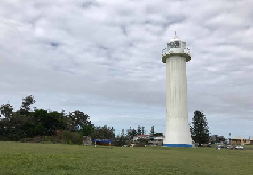
2- ENJOY A YAMBA BEACH
Yamba’s main drawcard is its amazing beaches and there are 11 to choose from between Yamba and Angourie, which is a smaller town 5km to the south of Yamba.
Some would say that Yamba’s has the best beaches in Australia.
Spend the day sunbathing and swimming at Turners Beach or Main Beach or discover one of the quieter beaches.
Here are the top beaches to explore around Yamba.
Main Beach
The beach below the historic Pacific Hotel is patrolled in summer and has a saltwater rock pool that is great for kids.
Main Beach is also home to the Surf Life Saving Club.
The rock pools are great for kids to look for crabs and facilities at the beach include a kiosk, picnic tables and toilets.
Turners Beach
Between the break wall and the lighthouse, Turners Beach is also patrolled in summer and has toilets, showers and picnic tables.
The northern and southern ends of Turners Beach is popular for surfing. The surf break is protected from the wind by the point and is a relatively safe surf break for younger surfers.
Rock fishing or fishing off the break wall is also a fun thing to do.
Whiting Beach
When the surf’s up and if you’re looking for a calm beach for the kids, head to Whiting Beach.
This river beach is a great spot to cool off without the waves and is a popular place to go fishing.
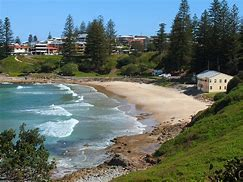
3- GO SURFING IN ANGOURIE
Any keen surfer will tell you that Angourie is an internationally recognised surfing destination with several challenging breaks. And if you’re a surfer you already know that surfing is the top thing to do in Yamba.
Back Beach (south of Angourie Point) is the beach to go if you’re an experienced surfer and Angourie Point is the place that draws serious surfers.
It’s one of a few protected surfing reserves in Australia.
Spooky Beach is north of Angourie Point and another option for experienced surfers but brave beginners might like to throw their boards in the water here too.
Pippi Beach has lovely views and is a popular beach for summer surfing competitions.
4- WALK ALONG THE BREAKWALL
The Yamba breakwalls, where the Clarence River meets the ocean, were built between 1950 and 1971 to stop the sand buildup.
The walls protect the channel from the large waves that threatened boats cruising through the channel.
The Yamba breakwall is also a fantastic place to go for a walk, especially at sunset.
You’ll find the breakwall between Whiting Beach and Turners Beach.
5- GO GAME FISHING
The warm waters off Australia’s east coast are perfect for fishing and it should come as no surprise that one of the top things to do in Yamba is to go fishing.
If you’re keen on sport fishing, Yamba is a good place to fish for various types of Marlin (blue, black and striped) as well as Mahi-Mahi, Sailfish, Tuna, Wahoo and Mackerel.
There’s a choice of fishing charter companies that will take you out on a fishing tour or charter a boat and head off on your own game fishing adventure.
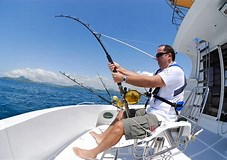
6- GO WHALE WATCHING
See whales and dolphins on a whale-watching cruise or from the headlands during their annual migration.
You can spot the humpback whales all along the east coast and if you’re there when the whales are migrating (July to October) put whale watching as one of the things to do in Yamba on your activity list.
Although Yamba doesn’t have a well-developed whale watching industry like Hervey Bay in Queensland, it’s possible to have some amazing experiences on the water.
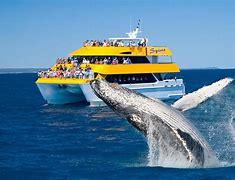
7- RELAX ON A CLARENCE RIVER CRUISE
A history cruise on the Clarence River is a relaxing way to enjoy the waterways around Yamba.
Clarence River Ferries operates this cruise on Wednesdays, departing from Yamba (11 am) and Iluka (11.45 am) cruising the waterways for a few hours and returning to Yamba at 3 pm.
Scenic river cruises cost $25 (half price for kids) and normal ferry rides operate daily and cost $8. For more details go here.
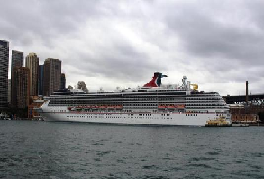
8- EXPLORE ILUKA
On other days, catch the ferry to Iluka, where you’ll find the freshest prawns (caught by the commercial fishing fleet) at the Clarence River Fishermen’s Co-op.
Iluka is a small fishing village that is also popular for recreational fishing as there are several good fishing spots along the river.
The Iluka Rainforest walking track is a lovely 2.6km seaside rainforest walk past strangler figs and vines to stunning views from the headland. Keep an eye out for sea eagles, ospreys and oystercatchers.
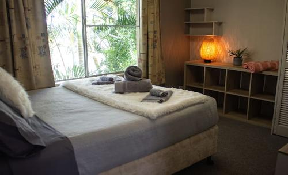
9- VISIT ANGOURIE’S GREEN AND BLUE POOLS
A former bluestone mine up until 1899, Angourie’s freshwater green and blue pools are popular picnic spots and swimming holes.
The former quarrying sites supplied the rock used to build the Yamba break wall.
These are fairly deep swimming holes to cool off in but is not suitable for swimming all year round due to toxic algae in the water. Check the council’s website before going.
The pools are in the Angourie Reserve (between Spooky Beach and Angourie Beach).
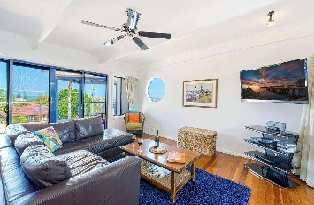
10- DISCOVER YURAYGIR NATIONAL PARK
Yuraygir National Park stretches from Angourie to Red Rock and is a coastal national park where generations of the Yaegl and Gumbaynggirr people camped and fished.
The park has a spiritual significance to the Aboriginal community and has diverse bioregions, including littoral rainforest, eucalypt forest, woodland and wetlands.
It’s the place to spot coastal emus, which are now an endangered species (there are less than 100 left in this park), squirrel gliders, eastern grass owls and rufous bettongs, which are rare marsupials.
The national park has campground facilities and short walks but if you’re a keen hiker, plan to do the four-day hike.
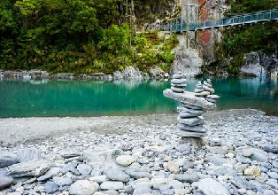
11- SHOP AT A YAMBA MARKET
The two main markets in Yamba are the Yamba River Markets and the Yamba Farmers and Producers Market.
YAMBA RIVER MARKETS
Yamba River Markets happens on the fourth Sunday of each month at Ford Park, River Street, Yamba, and is a great place for breakfast, coffee and to shop for fruit, vegetables, meat and jams and taste German-style bratwurst and Kransky.
YAMBA FARMERS AND PRODUCERS MARKET
Yamba Farmers and Producers Market is on Wednesdays between 7 am and 11 am in the car park between Whiting and Turners Beach.
Organic, chemical-free and free-range are the buzz words at this market.
12- SEE A SHOW AT THE YAMBA CINEMA
The Yamba cinema is in a quaint timber building and has three movies on rotation every week. Check out the shows here.
Yamba Cinema is at 13 Coldstream Street, Yamba.
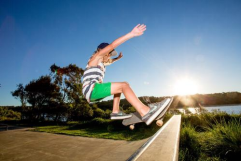
13- WALK THE YAMBA HISTORIC TRAIL
Spend a couple of hours on foot or hire a bicycle to explore the Yamba historic trail. Start at the Yamba Historic Museum (which is worth spending some time in, even if you’re not doing the walk – see below).
Walk past Lion’s Park and the Yamba Fire Station, which dates back to 1957 and turn left into Coldstream Street then walk past the Yamba Oval. The picket fence was erected in 1936 and is still standing.
Turn right into Claude Street and left into Wooli Street, past the fibro cottage at the corner to One Mile Peg and Fred Phillips Memorial Park. Fred Phillips was a storekeeper, oyster farmer and shire council member in Yamba who contributed to the community.
Continue along Wooli Street to the Angourie Road roundabout. The road to Angourie was built on the railway line, which was used to transport rock for the construction of the Middle Wall and the southern breakwater wall.
Walk across the bridge towards the river and turn left towards the Yamba fishing fleet and continue along to Ford Park, which was formed by filling in Blacks Bay and Barclay’s Bay (named after fisherman and oyster farmer George Barclay).
Continue following the trail to Whiting Beach on Hickey Island and Shoal Bay, which was named by Matthew Flinders in 1799, and on to the Breakwater, Turner’s Beach (named after the works paymaster who drowned here) and onto Harbour Street.
Look for the Flinders Well memorial, which is on the spot where Matthew Flinders found water when he landed in Yamba.
Other buildings to see are the Ritz Building on the original site of the Pacific Hotel, opened by Captian William Mann in 1873, the Yamba Library was once the School of Arts Hall and the place where dances and public meetings were held and the heritage-listed Yamba Police Station built in 1903.
14- VISIT THE PORT OF YAMBA HISTORICAL MUSEUM
This small museum operated by the Port of Yamba Historical Society has displays that focus on Yamba’s maritime history.
Objects include Francis Freeburn’s (the first pilot in Yamba) telescope, exhibitions on shipwrecks and submarines, and a display of the public education system in Yamba.
It’s a good place to connect with local historians and volunteers.
Yamba Museum is on River Street, Yamba. Opening hours are Tuesday to Thursday (10 am to 4.30 pm), Saturday and Sunday (2 pm to 4.30 pm). Entry fee is $3 (free for children).
15- GO LAWN BOWLING
The Yamba Bowling Club allows bowlers of all levels to enjoy and learn the game, so if you’ve never tried bowling, this is the club to give it a go.
The club runs a barefoot bowls programme (for kids aged 12 years and above) during school holidays
The club offers free coaching and you can find the weekly programme and roll-up times here.
Yamba Bowling Club is in the Bowlo Sports & Leisure complex, 44 Wooli Street, Yamba.
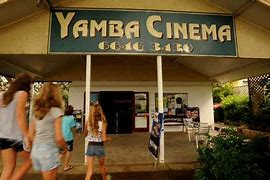
16- GO TEN PIN BOWLING
Looking for something to do in Yamba on a rainy day? If you’re visiting with kids, head to the Bowlo Sports & Leisure Club for a game of ten pin bowling.
Besides a four-lane ten pin bowling alley, the centre also has an 18-hole mini-golf course (with sand bunkers and water traps) and a rock-climbing wall.
Bowlo Sports & Leisure Club is at 44 Wooli Street, Yamba.
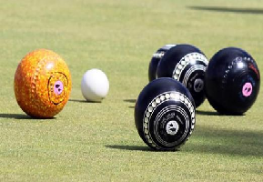
17- MAKE NEW FRIENDS IN A YAMBA PUB
Yamba’s laid back vibe makes it a friendly place and one of the best places to meet new friends is in a Yamba pub.
Yamba Shores Tavern
Yamba Shores Tavern is a large waterfront pub, bistro and deck where you can sit for lunch or dinner.
There’s a large playground for the kids and a rolling roster of bands and other live entertainment.
Yamba Shores Tavern is at 64 The Mainbrace, Yamba
18- DELVE INTO SCOTTISH HISTORY IN MACLEAN
Soak up Scottish history in the historic town of Maclean, which is a mosaic of farmland, cane fields, fishing boats on the river and tartan-painted power poles.
Other attractions with a Scottish flavour are the Maclean Bicentennial Museum and the Scottish Cairn, which is a memorial built in honour of the region’s Scottish settlers.
The best time of year to visit Maclean is during the Highland Gathering festival at Easter time, when there are concerts on the street, kilts, bagpipe music and traditional highland games.
We happened to roll up to Maclean at the start of the ANZAC Day parade, just as an F18 flew over the town.
The flyover was followed by the parade where hundreds of people marched past cute buildings and the bagpipe band created a stirring atmosphere.

19- GO FOR A DRIVE TO GRAFTON
Follow the Clarence River – past Maclean – to Grafton, which became a city in 1885.
Attractions along the way include Woodford Island and its McFarlane Bridge, which is 100 years old.
There’s a quaint radio museum in Lawrence and the Grafton Heritage trail is a delight to explore.
Grafton is a handsome city with delightful heritage architecture and a number of National Trust buildings, such as the Grafton Gaol.
The best time to visit Grafton is during the Jacaranda Festival (October) when the city’s handsome avenues ablaze with purple blossoms.
20- PLAY GOLF AT THE YAMBA GOLF & COUNTRY CLUB
The Yamba Golf & Country Club’s first three holes were built in 1956 and the golf course has grown from strength to strength, being named QLD PGA Regional Pro-AM in 2016 and 2017, two years in a row.
Even if you’re not a golfer, you’ll enjoy the lovely view from the clubhouse and The Deck Café is a good spot for breakfast, coffee or a drink.
The club also has a live entertainment programme and social activities.
Yamba Golf & Country Club is at River Street, Yamba. Green fees for members are $12 for a social game. If you’re a beginner, a two-month introductory membership costs $50. Social membership costs $10 a year.
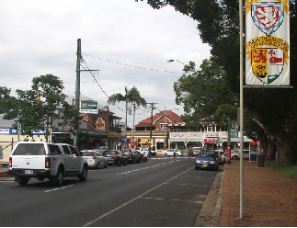
https://travel2next.com/yamba/
VI. History and Culture
The Yaegl People are the traditional custodians of the coastal areas around Yamba, Iluka and Maclean, having lived here for 60,000 years. Yaegl country covers a relatively small area due to plentiful resources both from the ocean and the Clarence River that could support a larger population. For the same reason, the Yaegl people were also less nomadic, moving less frequently between a few main camps. Other groups did visit and they travelled great distances to other regions, including southern Queensland, for ceremonial and other special events.
The first white person to visit this area, Matthew Flinders (1799), described large bark huts with rounded passageway entrances which protected dwellers from wind and rain. Similarly Captain Perry (1839) described canoes of a superior construction. The Yaegl people continued to practise their traditional way of life until white settlers arrived. The Yaegl people initially co-existed with the early settlers but decreased markedly in numbers after the selectors took up the land for maize and later cane growing. The locking up of land in small farms and the displacing of the original owners, the Yaegl people, was not a deliberate policy of dispossession but certainly had that effect. Their traditional way of life began to disappear as Yaegl people took work, cutting timber and later sugar cane, and other seasonal labouring jobs.
In 1904 the Aboriginal Protection Board set up an Aboriginal Reserve on Ulgundahi Island near Maclean, formalising the segregation of Aboriginal and non-Aboriginal settlement. Whilst Aboriginal people still visited Yamba for holidays, revisiting their traditional lands, it was only after 1945 when one particular Yaegl elder left Ulgundahi Island that Yaegl people returned permanently to Yamba.
In 1945 Rocky and Bella Laurie permanently moved their family off the island to Reedy Creek (near current Blue Dolphin resort) and then into Yamba (setting up camp at current Story Park) where the community continued to grow. However in the 1950s they were forced to move to Angourie Road, to a camp near the then racecourse (now occupied by the Raymond Laurie Sports Centre). In 1966 the community moved again to Pippi Beach Reserve, now known as Ngaru Village; however, many individuals now live and work among the non-Aboriginal community in Yamba.
Despite the loss of their country – much of which is now encompassed within the Yuraygir National Park (proclaimed 1980) – the reef that sits at the mouth of the Clarence river remains under Native Title so cannot be removed. Other important Yaegl sites are now referenced on a unique map created by Charlene Williams, a Yaegl woman, on display in the Yamba Museum. Another useful reference for visitors, the Lower Clarence Aboriginal Tourist Drive can be downloaded or is also available at the Yamba Museum.
Today there are two Local Aboriginal Land Councils (LALC): Yaegl LALC at Hillcrest, Maclean and Birrigan Gargle LALC at Ngaru Village, Yamba. They strive to preserve their heritage and culture as witnessed by the publication in 2012 of the Yaygirr Dictionary and Grammar book.
The Port of Yamba Historical Society takes pride in their collaborative partnership with the Yaegl community that has produced improved permanent displays that integrate Yaegl and non-Aboriginal history as well as an award winning Aboriginal art exhibition, Vision4Change, in 2013 and our “Friendship Trees” in 2014.
http://www.pyhsmuseum.org.au/yamba-history/first-peoples/
The Yaegl people had lived in this area for 60,000 years before the first white man arrived. Matthew Flinders visited briefly in July 1799 looking for a big river which would give access to land suitable for the establishment of new convict settlement, since Port Jackson was bursting at the seams and barely able to feed its involuntary inhabitants. However he mistook the river entrance for a bay which he named Shoal Bay and then sailed on to Moreton Bay.
Around 1830 an escaped convict named Richard Craig, trying to make his way back to Sydney, came upon the ‘Big River’ (Clarence). He reported on arrival at Port Macquarie that there were great stands of valuable cedar there, so in 1838 the first settlers arrived in Thomas Small’s schooner, the “Susan”. After clearing the cedar they settled on the fertile river flats to raise cattle and to grow grain.
The discovery of the Clarence River changed the traditional lifestyle for the Yaegl people and they became fringe dwellers.
The first permanent European residents of Clarence Heads (as Yamba was then known) were the crew of the signal station set up on Pilot Hill in 1854 under Captain Frances Freeburn. Their work was vital as the dangerous bar at the river mouth threatened the growing commercial importance of the region as people and supplies moved in and out of the river entrance.
In response to agitation to have the entrance made safe, the government allocated money for harbour works to begin in 1862. This led to an influx of workers and the establishments of commercial enterprises to provide them with housing, food and other services.
http://www.pyhsmuseum.org.au/yamba-history/newsettlement/
Yamba was officially proclaimed a town in 1864 and during the first fifty years of European settlement the river was the main means of access. The small population fluctuated with the periodic allocation of government funds for the harbor improvement works. Yamba was regarded as a sleepy little fishing village apart from when upstream holidaymakers came by riverboats to enjoy the beaches and the fishing.
After the railway from Sydney reached Grafton in 1923 and the sealing of Yamba Road began in the 1930s, Yamba really began to develop as a tourist destination. A bus service to Grafton had been established in the early 1900s and by the 1940s road transport had displaced river boats. Visitors were able to use bridges rather than punts and ferries to reach Yamba, and Yamba Road was fully sealed in 1958. Guest houses were replaced by motels and holiday apartments. Camping was always popular and the 1960s saw the establishment of caravan parks. The progressive filling of the bays along the Clarence foreshore made this an ideal site for camping and recreation.
Fishing and oyster beds had been important industries since the 1880s and prawn trawling was pioneered in the 1940s. Sugar cane farming had replaced grain as a major crop in the late 19th century and by 1978 the cane cutting process was fully mechanised.
The subdivision of the CBD was a gradual, ongoing process from as early as the 1880s. By the 1970s when the harbour works were coming to an end, the water supply was in place, the town had electricity and sewerage and streets were fully constructed. By the 1960s Wooloweyah was opened up for sale and during the 1980s there were several estates developed further west off Yamba Road. Yamba Public School was established by the end of the 19th century, but a hundred years later was relocated to a larger, more modern campus on Angourie Road. St James Catholic Primary school was opened in 2000.
Yamba has come a long way from its first telegraph station in 1870 to a mobile phone tower next to Yamba Fair shopping centre in 2013; from a sleepy fishing village in the 19th century to a popular retirement and holiday resort in the 21st century. Today Yamba has a population of some six and a half thousand, which can double during peak holiday periods, yet it remains a friendly community for residents and visitors alike!
http://www.pyhsmuseum.org.au/yamba-history/development-and-growth/
How Yamba in the Clarence Valley on the NSW North Coast hasn’t become the next Byron Bay is anyone’s guess. That’s not to say it’s a complete secret; but with its world-famous surf breaks, perfect beaches and a town with the right amount of buzz, it should be Australia’s favourite beach escape.
Surfing and fishing
Just south of Yamba is Angourie, a National Surfing Reserves. Angourie Point is one of the best right-hand point breaks in Australia. If the waves are off – or when you’re done getting tubed – there are multi-day coastal hikes in the national park beside the break. Or swim in the natural springs of Angourie’s blue and green pools.
Fishing fans can catch plenty of fish either at the beach, estuary or off the rocks. You can hire boats and special fishing kayaks, and drop into one of the numerous bait and tackle shops for tips on where the fish are biting. Deep sea fishing is legendary here too. Both Reel Time Charters and Yamba Fishing and Charters offer fishing expeditions in the Pacific.
Things to do
With mild Winters and long, temperate Summers, Yamba is a perfect escape all year round. A kayaking tour with Yamba Kayak will get you eye-to-eye with wild dolphins in the estuary, while Clarence River Ferries offer scenic cruises and a passenger service to Iluka, on the northern side.
There are parks beside the river for picnics, a good golf course and walks to local landmarks, like the Yamba Lighthouse and the 1934-built Pacific Hotel. The town is built around a national park, too, and humpback whales put on breaching shows just off-shore during their annual migration between May and November.
The Yuraygir coastal walk south to Red Rock follows ancient emu trails in the Yuraygir National Park. There are seaside villages such as Brooms Head along the 65km hike, and campgrounds are dotted along the track.
https://www.visitnsw.com/destinations/north-coast/clarence-valley/yamba
VII. Contact Information
Mayor: Cr Jim Simmons
Contact Details
Phone: (02) 6643 0203
Mobile: 0436 413 120
Postal: Locked Bag 23, Grafton, 2460
Email: jim.simmons@clarence.nsw.gov.au
Cr Jason Kingsley
(Deputy Mayor)
Contact Details
Mobile: 0422 828 156
Postal: Locked Bag 23, Grafton, 2460
Email: jason.kingsley@clarence.nsw.gov.au
Tel (02) 6643 0200
Email council@clarence.nsw.gov.au
Postal Address
Locked Bag 23
Grafton NSW 2460
Street Address
2 Prince Street, Grafton, and
50 River Street, Maclean
https://www.clarence.nsw.gov.au/cp_themes/metro/page.asp?p=DOC-KCR-17-10-14
